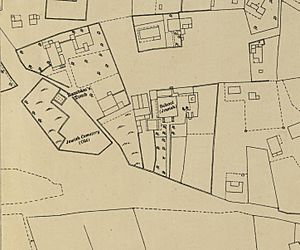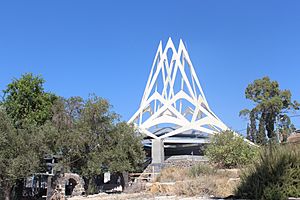Tomb of Maimonides facts for kids
According to Jewish tradition, the Tomb of Maimonides (Hebrew: קבר הרמב"ם, romanized: Kever ha-Rambam) is in central Tiberias, on the western shore of the Sea of Galilee, Israel. Maimonides died in Fustat, Egypt on 12 December 1204, where it is believed that he was briefly buried before being reinterred in Tiberias. The Tomb of Maimonides is one of the most important Jewish pilgrimage sites in Israel, and one of Tiberias's most visited tourist attractions. The place of the tomb of Maimonides is also the burial place of Rabbis Yochanan ben Zakai and Isaiah Horowitz.
Legends
Many legends are told about the burial of Maimonides. According to Jewish tradition, his bones were placed for a week in a small shrine where he used to study and to heal strangers. While some believe his bones never left Egypt, others believe that the permanent place of his burial was on the western shore of the Sea of Galilee, where Tiberias is now sited. One legend has it that a band of Bedouins – who were about to attack the funeral cortège as it marched through the desert – "hung their heads in shame" after realizing it was the funeral of the man who had attended themselves and their families for free, and instead formed a protective guard for the procession as it made its way to Israel.
Another legend was told by Joseph ben Isaac Sambari, a Jewish-Egyptian chronicler of the seventeenth century, who lived probably between 1640 and 1703. In one of his books Sambari mentioned an oral anecdote about the people who carried his body to the Sea of Galilee for permanent burial mistakenly leaving one of his toes behind in the Maimonides synagogue, which at that time was called the synagogue of Western (Tunisian) Jews. Later one of the people who carried the body had a dream, in which a wise man of Egypt reminded him about the forgotten toe. The toe was recovered and buried next to the body.
Tiberias

The earliest source for the claim that Maimonides is buried in Tiberias is Al-Qifti, and this view is corroborated by a wide variety of 13th–15th century chronicles. The earliest source to introduce doubt was Samuel Shullam, who wrote "He was buried in Tiberias, or, as some say, he was buried with the Patriarchs in Hebron." Most modern scholars agree that Maimonides was buried in Tiberias, though Armand Kaminka [he; de; pl] argued that his body never left Egypt.
Rabbi Ya'akov Moshe Toledano originally purchased the land around the tomb in 1920. As a result, the tomb was transferred to Jewish ownership.
At the end of 1955 the Religious Services Minister of Israel began excavation work at the site of the tomb, and soon many additional graves were discovered around the tomb of Maimonides. Despite the discovery of graves, the Department of National Roads Company of Israel continued work on the site.
The government's desecration of known graves led to protests from the city's and country's religious Jewish communities. Neturei Karta volunteers showed and protected the graves throughout the day in organized shifts to prevent the government's workers and archaeologists from approaching the graves and mistreating known remains. Volunteers from Bnei Brak joined those protecting the graves, and held demonstrations in the streets of Tiberias to draw public attention to the government's actions.
When one of the government's tractors working at the site hit the nearby grave of Isaiah Horowitz, the volunteers forced the tractor's driver to leave the site. Following this attack on the graves, the government was forced to suspend work at Maimonides' tomb site. Representatives of the Religious Services Minister of Israel and the Chief Rabbinate pledged that no excavation work would be done in the site.
Later, a large metal structure was erected over the tomb complex. It symbolizes a crown, indicating the great respect accorded Maimonides in Jewish tradition.



